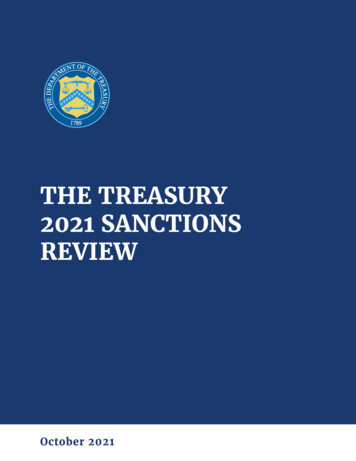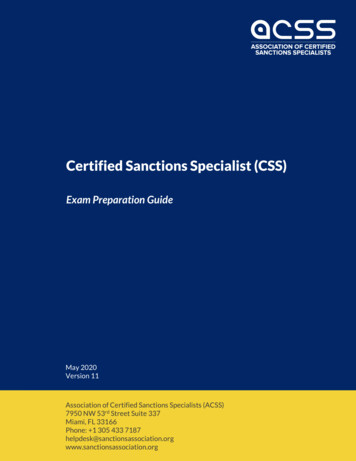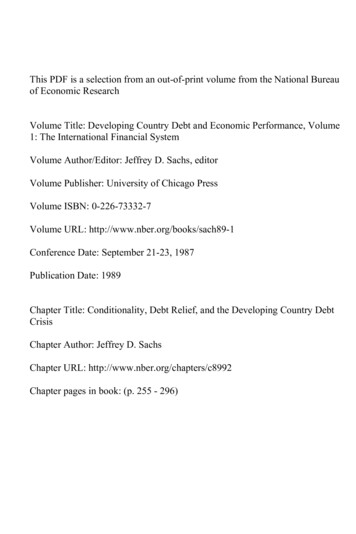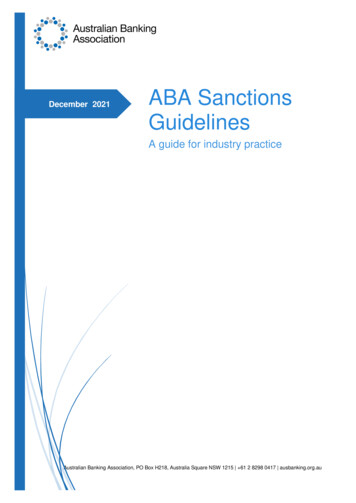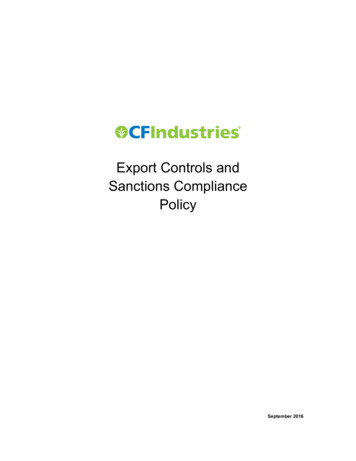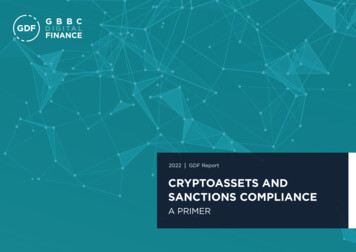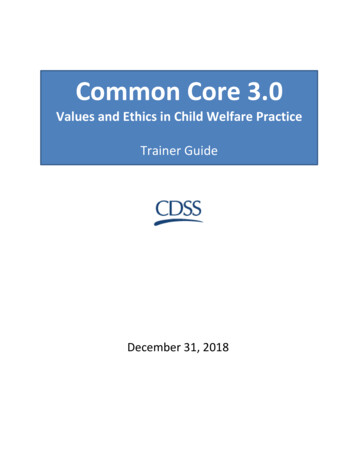
Transcription
WELFARE SANCTIONS ANDCONDITIONALITY IN THE UKConditional welfare arrangements require people to behave in a certainway to access welfare goods, such as cash benefits, housing or supportservices. These behavioural conditions tend to be enforced throughpenalties or ‘sanctions’ that reduce, suspend or end access to thesegoods. This paper examines the efficacy and ethicality of conditionalforms of welfare. It considers existing evidence about how effectivewelfare conditionality is at achieving and sustaining desired forms ofbehavioural change; what the impacts are; how different groups fare;and to what extent welfare conditionality can be morally justified.Key points Behavioural requirements for out-of-work-benefits are the most high-profile form of conditionality,but pronounced strands of conditionality have also emerged in relation to anti-social behaviour, socialhousing and homelessness policies, particularly in England. Sanctions are now used much more frequently within the welfare benefits system. The severityof sanctions has also increased and conditionality is now applied to previously exempt groups(e.g. lone parents, disabled people). Benefit sanctions are having a strongly disproportionate effect on young people under 25, and thereis also evidence of severe impacts on homeless people and other vulnerable groups. International evidence indicates that benefit sanctions (especially severe sanctions) substantially raiseexits from benefits, and may also increase short-term job entry; but the longer-term outcomes forearnings, job quality and employment retention appear unfavourable. Little evidence is available on the impact of welfare conditionality in other spheres, such as social housing. There is qualitative evidence to suggest that, with appropriate support, interventions includingelements of conditionality or enforcement may deter some individuals from anti-social behaviourand street-based lifestyles. The ‘theories of behaviour change’ underpinning conditionality have been questioned bycommentators from both the Right and the Left, particularly with respect to the assumed ‘rationality’of welfare recipients’ responses to financial sanctions and incentives. There are also concerns that welfare conditionality leads to a range of unintended effects, including:distancing people from support; causing hardship and even destitution; displacing rather thanresolving issues such as street homelessness and anti-social behaviour; and negative impacts on‘third parties’, particularly children.AuthorsBeth Watts, Suzanne Fitzpatrick, Glen Bramley and David Watkins, with contributionsfrom the ESRC funded ‘Welfare Conditionality: Sanctions, Support and Behaviour Change’project research team.SEPTEMBER 2014
INTRODUCTIONThis Round-up synthesises evidence collected during the initial stages ofa five‑year Economic and Social Research Council (ESRC) funded researchstudy – ‘Welfare Conditionality: Sanctions, Support and Behaviour Change’ –being conducted by six UK universities1.The study focuses on two key questions: How effective is welfare conditionality in promoting and sustaining behaviour change amongstwelfare recipients? To what extent, and on what grounds, can welfare conditionality be morally justified?It seeks to establish a comprehensive evidence base on the efficacy and ethicality of conditionalityacross a diverse range of welfare service users, including: unemployed people; lone parents; disabledpeople; social tenants; homeless people; individuals/families subject to anti-social behaviour orders orfamily intervention projects; offenders; and migrants.The study is predominantly qualitative in nature, involving a major programme2 of interviews withsenior policy-makers and other influential ‘key informants’; focus groups with frontline workerscharged with implementing conditional welfare policies; and repeated in-depth interviews with ‘welfarerecipients’. It compares the implementation of welfare conditionality in England and Scotland, andacross six case study cities (Bristol, Edinburgh, Glasgow, London, Peterborough and Sheffield).This Round-up synthesises evidence gathered in the first year of the project, prior to the start ofthe fieldwork. It draws on the following sources: current UK and international evidence on the effectiveness and ethicality of conditional formsof welfare; a series of policy briefing papers3 detailing the application of conditionality to the eight welfarerecipient groups above; statistical analysis of available quantitative data on the volume and trends in the applicationof benefit sanctions and other aspects of welfare conditionality4; and a theoretical mapping of key concepts associated with welfare conditionality.What is ‘welfare conditionality’?Welfare recipients are subject to various forms of ‘conditions’ when accessing state support, includingthe following (adapted from Clasen and Clegg, 2007): Conditions of category: entitlements are conditional on membership of a defined category ofsupport (e.g. being unemployed, disabled, homeless, etc.); Conditions of circumstance: eligibility criteria exclude or include individuals on the basis of theircircumstances (e.g. passing a means test or demonstrating a particular level of need); Conditions of conduct (i.e. behavioural conditions): demand for particular patterns of behaviourfrom welfare recipients.The recent shift towards a much greater emphasis on conduct conditionality is the main focus ofthis Round-up (Dwyer and Wright, 2014). While the application of sanction-backed behavioural02
conditions within the benefits system are often seen as the ‘archetypal’ form of welfare conditionality,increasingly conditional approaches have also emerged in other areas of social policy, including inrelation to social housing, homelessness and anti-social behaviour (ASB). Behavioural conditions tendto be enforced through the use of penalties that reduce, suspend or end access to benefits, housingor other welfare ‘goods’, though conditional welfare arrangements may also combine sanctions withsupport and/or incentives to enable and encourage welfare recipients to behave in particular ways.Relevant interventions range from overt ‘punishments’ – such as the withdrawal of benefits, evictionfrom social housing, or the imposition of Anti-Social Behaviour Orders (ASBOs) – to broader formsof ‘social control’ that seek to change behaviour through a more subtle mix of ‘nudging’, ‘persuasion’and/or ‘social pressure’ (Dolan, et al., 2012; Grant, 2012).Conditionality in welfare benefitsThe evolution of conditionality in welfare benefitsConditionality has been a longstanding feature of welfare benefit entitlements in the UK. Access tounemployment benefits, for example, has always been conditional on recipients being involuntarilyunemployed and available for work. However, the scope and scale of behavioural forms ofconditionality, as well as the severity of the sanctions applied for failure to comply with the requiredconduct (e.g. attending appointments with employment advisers), has increased substantially since the1980s. Some particular groups - notably lone parents, sick and disabled people, offenders and somecategories of migrants - have also been targeted for specific conditionality measures.A series of social security reviews conducted by the Conservative Government (1979–1997) led tothe introduction of a ‘stricter benefit regime’ from the late 1980s and culminated in the introductionof Job Seekers Allowance (JSA) in 1996, a pivotal change which intensified monitoring of unemployedclaimants’ job-seeking behaviour. The incoming Labour Government in 1997 adopted a ‘work first’and ‘work for all’ approach, embracing JSA’s monitoring of claimants’ job search activities, backed upby benefit sanctions in cases of non-compliance. A range of measures were also introduced to ‘makework possible’ and ‘make work pay’, including increased financial support for childcare, as well as theintroduction of the National Minimum Wage, increased levels of Child Benefit, and tax credits to assistlow-income families.These ‘enabling’ measures were implemented alongside an expansion in the reach of work-relatedconditionality to previously exempt groups, with lone parents – previously subject to ‘light’ if anyconditionality – increasingly targeted (Whitworth and Griggs, 2013). Compulsory ‘Work FocusedInterviews’ for lone parents on Income Support (IS) were introduced from 2001. Lone ParentObligations (LPO), implemented from 2008, have seen an incremental reduction in the age thresholdof the youngest child that enables lone parents to qualify for IS, rather than the much more conditionalJSA; by 2012, this threshold had been lowered to age 5. Under LPOs, lone parents deemed able towork are treated in broadly similar terms to other JSA claimants, albeit that some LPO ‘flexibilities’have been incorporated to recognise the responsibilities involved in caring for a child. Also in 2008,Employment and Support Allowance (ESA) was introduced to replace Incapacity Benefit (IB) and IS forsick and disabled people, with this benefit embracing more conditional elements (and the use ofsanctions) for those deemed capable of ‘work-related activity’.The current UK Coalition Government has further intensified benefit conditionality. Initially, thisincluded a dramatic increase in the use of fixed length sanctions (imposed for failure to satisfywork‑related activity requirements), while varied length sanctions (associated with ‘voluntaryunemployment’) and entitlement sanctions (related to benefit eligibility), which previously dominated,tended to decrease or remain static, although the recession may have affected these as well (e.g. fewerpeople leave jobs voluntarily when job opportunities are scarce). Under a new JSA sanctioning regimeintroduced in October 2012, the maximum sanction – for repeated ‘high level’ non-compliance – isnow complete withdrawal of benefits for three years. Claimants in the ‘work-related activity group’(WRAG) of ESA also face more stringent sanctions under a new regime introduced in December2012: those who fail to comply with the conditions for receiving the benefit now receive an openended sanction, followed by a fixed period sanction when they re-comply. The sanctionable amounthas increased to 100 per cent of the work-related activity component of benefit for a single claimant(from 50 per cent for the first four weeks and 100 per cent thereafter under the previous regime).03
The Work Programme (WP) – introduced in 2011 – consolidates previous employment programmesand contracts out responsibility for employment support to private companies and third-sector bodies,with a significant ‘payment by results’ element. Offenders who claim JSA now enter the WorkProgramme from ‘day one’ of their prison release, rather than 9 or 12 months after starting claimingas for other groups (Ministry of Justice (MOJ), 2010; Fletcher et al., 2012). In addition, any individualclaiming JSA within thirteen weeks of leaving custody will be mandated to the Work Programme.These developments reflect policy-makers’ ambition to help unemployed offenders into work as ameans of combatting recidivism, and were given further impetus by a landmark Government datasharing project which revealed that a substantial proportion (26 per cent) of claims for out-of-workbenefits in England and Wales at 1 December 2010 were made by ‘offenders’ who had received atleast one caution or conviction between 2000 and 2010 (the equivalent figure for JSA specifically was33%), with 5 per cent of claims made by offenders who had been released from prison during thesame period (MOJ & DWP, 2011).Recent and ongoing UK immigration and asylum policy has strengthened the long-established linkbetween migrants’ legal status and widely divergent rights to residence, work and welfare (Dwyer et al.,2011). Alongside ‘stratified conditions of eligibility’ (Morissens and Sainsbury, 2005) the notion of‘earned citizenship’ has become more prevalent, with permanent residence and access to full rights towork and welfare increasingly conditional on migrants demonstrating economic self-sufficiency. Mostrecently, the UK Government has introduced new measures to further limit European Economic Area(EEA) nationals’ rights to access benefits. These include a minimum earnings threshold, a ‘genuineprospect of work test’ and restrictions on entitlement to Housing Benefit, Child Benefit and Child TaxCredit for newly arrived EEA ‘jobseeker’ nationals (BBC, 2014b; Kennedy, 2014).The roll out of Universal Credit further extends the scope and strictness of the conditionality regime.Individual ‘Claimant Commitments’ (now in place in most Job Centre Plus offices) increase job-seekingexpectations for most claimants, with the default requirement that claimants treat looking for work astheir full-time job. In addition, claimants of Universal Credit who are in work but on a low income areto be subject to conditionality for the first time. Those whose weekly gross earnings fall short of a‘conditionality threshold’ (equivalent to around 35 hours work per week paid at national minimumwage rates) will be expected to meet the threshold by working more hours and/or increasing their payrate, finding a second job to supplement their income, or getting a new job with better wages;otherwise they are potentially subject to sanctions (DWP, 2010; Dwyer and Wright, 2014). TheMinister for Employment recently announced a big change in the nature of benefit conditionality, withnew jobseekers set to face pre-claim behavioural requirements including preparing a CV, setting up anemail address and registering on the Government’s new jobs website ‘Universal Jobmatch’ (DWP, 2014).Statistical evidence on the use of sanctions within welfare benefitsStatistics on the rates of ‘referrals’ of JSA claimants for sanctioning, and ‘adverse decisions’ resultingin actual sanctions, indicate four phases over recent years: relative stability from 2000–2006; a pulseof increased referrals and sanctions through 2007 and 2008; then an increasing use of referrals andsanctions after the Coalition Government took up office in 2010 (see Figure 1); finally, after droppingback in 2011, sanctions have surged upwards to higher levels through 2012 and 2013. Overall,monthly sanctions rates have risen from about 2 to 2.5 per cent of claimants in this earlier period, toaround 3.5 per cent in 2008, and 5 per cent in 2010–11, and again to around 6 per cent by late 2013(actually peaking at 7.3 per cent in October 2013).04
Figure 1: Monthly Referral and Sanction rates 2000-2013 – % of all JSA claimantsReferralsSanctions18% of JSA 008April2009April2010April2011April2012April2013It has been argued (Webster, 2014c and personal correspondence) that the 2007–08 spike reflecteda ministerial and policy change to strengthen conditionality at that time. Much higher generalunemployment following the onset of recession from 2008 through to 2010 led to a fall in the rate ofsanctions. Given that conditions in the labour market then did not significantly alter for a couple ofyears, the big pulse in referrals and sanctions in 2010–11 appears mainly to reflect the policy impactof the change of Government (see Webster 2013a, 2014c). In this light, the subsequent falling back in2011–12 is somewhat surprising, but appears to have resulted from the introduction of the WP, andthe shifting of the supervision of many claimants to WP contractors. By 2013 referral and sanctionsrates had once again risen, exceeding those in 2010 (also note the growing gap between referral andsanction rates, discussed further below).The number of sanctions issued by WP providers has escalated rapidly, with over 290,000 issued in2013, up from 185,000 in 2012 and over double the level issued by equivalent programmes before2010 (MacInnes et al., 2013; Oakley, 2014). Between the introduction of the new sanctions regime inOctober 2012 and September 2013, almost one million individuals were referred for sanctioning, andmore than half a million (528,000) received an adverse decision.Recent statistics show a substantial escalation in the JSA sanctions applied to vulnerable groups,specifically lone parents and disabled people (BBC, 2014a). There is also evidence that those withcomplex needs, such as homeless people, have been disproportionately affected by intensifying welfareconditionality (Crisis, St Mungo’s and Homeless Link, 2012; Homeless Watch, 2013). Recognition ofthis has prompted an easing of work requirements for some recently homeless JSA claimants, as longas they take reasonable steps to find accommodation5. Some minority ethnic groups may also bedisproportionately affected (Scottish Government, 2013, Bramley et al., forthcoming; see alsoWebster, 2013a), which could reflect issues around language, understanding and communication(Peters and Joyce, 2006; Dwyer, 2009). The recently published independent review of sanctionsapplied to JSA claimants through mandatory back to work schemes, undertaken by Matthew Oakleyon behalf of the Department for Work and Pensions (DWP), identified particular difficulties faced bythe most vulnerable claimants (e.g. those with limited understanding of English or learning disabilities).Advisers involved in the review identified “a ‘vulnerable’ group who tended to be sanctioned more thanthe others because they struggled to navigate the system” (Oakley, 2014, p.35). These patterns areconsistent with the international evidence, especially from the US, that the most vulnerable claimantsare at greatest disadvantage within highly conditional systems, for example, those with mental healthproblems or low levels of qualifications or work experience, as well as ethnic minorities (Pavetti et al.,2003; Meyers et al., 2006; Schram et al., 2009).05
However, what is most clear from the available UK statistical evidence is that young people are moreseverely affected by the rapid growth in benefit sanctions than other age groups. As Figure 2 indicates,the recent escalation of sanction rates applies to all age groups. But the under-25 group has had aconsistently higher sanction rate than other age groups, and individuals in this group account for41 per cent of all sanctions issued under the new regime from October 2012 to December 2013.Figure 2 confirms that sanctioning is now a significant risk for an under-25 JSA claimant, affecting8 per cent of claimants in this age group per month in 2010–11 (averaged over this financial year),and rising to 8.4 per cent in 2013–14 (part-year).Figure 2: Monthly adverse decisions as % of all JSA claimantsUnder 2525-3435-4445-5960 All2006/072007/089% of JSA 14Again, this heightened sanctioning risk for younger people is consistent with international evidence,particularly from the US (Pavetti et al., 2003), and has been apparent in the UK for some time (Petersand Joyce, 2006). One explanation that has been offered is that younger claimants have a more‘relaxed’ attitude to sanctioning as a result of the financial safety net provided for some by theirfamilies (Peters and Joyce, 2006, p. 17). Less reassuringly, it has also been suggested that they maybe more likely to live in insecure or chaotic circumstances that make it difficult for them to complywith the strictures of the welfare system, and/or have less experience in how to navigate a highlyconditional system (Fitzpatrick et al., forthcoming; YMCA, 2014). It is also possible that some director indirect discrimination within the welfare system is placing young people at particular risk offinancial penalties.Worryingly, a recent sharp rise in reserved/cancelled decisions6, particularly the latter, appears to relatelargely to errors in the paperwork submitted by WP contractors to DWP (Webster, 2014c). Morebroadly, there are increasing concerns about the levels of ‘wrongful sanctioning’, both in terms of theimpact on ‘innocent’ claimants and the cost of appeals processes to the State (Miscampbell, 2014b;Oakley, 2014), though (for reasons that aren’t entirely clear (Adler, 2013)) independent tribunal appealsare made by only a very small number of sanctioned claimants (on average 3.1 per cent of sanctionedclaimants appealed to tribunals in 2013, Webster, 2014d)7. Adler (2013) raises broader concerns aboutthe significant discretion accorded to frontline staff in imposing sanctions and the (increasingly) limitedmeans of redress available to sanctioned claimants.In the recent review of sanctions referred to above, Oakley argues that an effective sanctioningsystem must offer those who are sanctioned “easily accessible and understandable recourse to appeal,and potential redress”, and acknowledged the confusing and complex nature of the current system,recommending various ways the system can be made clearer for claimants.8 It should be noted thatthe scope of the Oakley review was limited to issues of communications and process, and to claimantsmandated to back to work schemes (HM Government, 2013, see also Webster, 2014a). However,Oakley does refer to wider issues noted in the evidence submitted, including the effectiveness andproportionality of the sanctions regime; the quality of sanctions decisions and employment support;and the application of sanctions through Jobcentre Plus (the majority of sanctions) and to ESA06
claimants (Oakley, 2014).9 While the number of sanctions issued to ESA claimants is relatively small incomparison with JSA sanctions, there is now a discernible upward trend in both the number and rateof ESA claimants who are sanctioned. The rate of sanctions for ESA WRAG claimants has risen from alow of 0.06 per cent per month in June 2011, to 0.69 in November 2013 and an estimated 0.86 percent in December 2013. This amounted to 4,789 ESA sanctions in December 2013, the highestmonthly figure since sanctions were introduced for this group in 2008 (Webster, 2014d).The impact and effectiveness of conditions and sanctions within welfare benefitsWhile some would argue that the ‘punishment’ of non-compliers (Webster, 2014b) and achievingreductions in welfare expenditure (Griggs and Evans, 2010) have now emerged as additional keyobjectives, the main stated goal of conditionality within the benefit system is to influence claimants’behaviour by incentivising them to actively seek work and move off benefits (Miscampbell, 2014b).Based on a systematic review of international evidence, Griggs and Evans (2010) conclude that:“. sanctions for employment-related conditions (full-family sanctions in the case of US welfaresystems) strongly reduce benefit use and raise exits from benefits, but have generally unfavourableeffects on longer-term outcomes (earnings over time, child welfare, job quality) and spill-over effects(i.e. crime rates).” (p.5)Evidence from the US makes clear that the very severe sanctions applied in some states have producedsubstantial declines in welfare programme caseloads (see also Mead, 2011), but the US evidence forpositive effects on job entry is far weaker, and with respect to earnings, is on balance negative.European evidence on the short-term effects of actually imposed sanctions on unemployment benefitclaimants demonstrates a consistent and substantial increase in employment entry rates and/or reducedunemployment durations, particularly when sanctions occur early in a claim (Muller & Steiner, 2008;Hofmann, 2008). However, while data on longer-term impacts is scant, a key study in Switzerland whichconsidered the effect of both the threat and imposition of sanctions found that they lowered thelikelihood of sustainable employment and incomes over time (Arni et a
The roll out of Universal Credit further extends the scope and strictness of the conditionality regime. Individual 'Claimant Commitments' (now in place in most Job Centre Plus offices) increase job-seeking . expectations for most claimants, with the default requirement that claimants treat looking for work as

